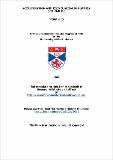Files in this item
Acculturation and bilingualism in Guambía (Colombia)
Item metadata
| dc.contributor.advisor | Gifford, Douglas J. | |
| dc.contributor.author | Long, Violet | |
| dc.coverage.spatial | 343 p. | en_US |
| dc.date.accessioned | 2012-07-10T08:29:40Z | |
| dc.date.available | 2012-07-10T08:29:40Z | |
| dc.date.issued | 1980 | |
| dc.identifier.uri | https://hdl.handle.net/10023/2955 | |
| dc.description.abstract | The objective of this study is to trace the relationship between oveit and covert acculturation and bilingualism in the Colombian Indian community of Guambia. The first section describes the ten indicators of innovative behaviour that form the Overt Acculturation Scale, on the basis of which the informants were allocated to three Acculturation Categories. These indicators, weighted according to their relative importance for the Guambianos, are: dress and language; occupation, migration and education; reciprocal labour, goods and the home, ritual and medicine, and access to the media. Acculturation has noticeably affected very few. These form an elite of well-educated young men who wear Western clothes, have specialised occupations and skills, and are well-acquainted with White culture and society through personal ties, migration and the media. All others are distributed along a continuum, taking more or less from the White World. Secondly, imaginative stories told in Guambiano and Spanish to a series of pictures by the informants were analysed for signs of covert acculturation. Six hypotheses were statistically tested which held that the ethnic identity of the characters portrayed, as Guambiano or White, would affect their personalities, actions, aims, interactions and emotions. Also, the acculturational level of the story- teller and the language used would affect the content, except for emotion. In Guambiano all display similar beliefs in traditional values and a similar acculturated are fav achievement-oriented show ambivalence and people and culture. Thirdly, these ethnocentrism; in Spanish the highly curable to White characters and more and ambitious, the slightly acculturated the unacculturated defend their own same stories were used to investigate bilingual proficiency. The range of syntactic constructions used in the two languages, the range of vocabulary found in Spanish, and the levels of grammatical and lexical interference in both languages were used as measures of oral productive proficiency. The majority shows sufficient proficiency in Spanish for inter-group communication, but some few have only a passive knowledge and others prove more fluent than in Guambiano on the test. The major conclusion is that the Guambianos' strong ethnic identity - symbolised in their dress, language, land and work - prevents greater acculturation. At present only the highly acculturated elite is innovative and bicultural, while the majority seeks to maintain its cultural heritage. It is economic interaction, not bilingualism, that will probably lead to eventual wholesale modification, since the Guambiano language remains strong but the economic situation grows ever worse. | en_US |
| dc.language.iso | en | en_US |
| dc.publisher | University of St Andrews | |
| dc.subject.lcc | F2291.G9L7 | |
| dc.subject.lcsh | Acculturation--Colombia--Guambía | en_US |
| dc.subject.lcsh | Bilingualism--Colombia--Guambía | en_US |
| dc.title | Acculturation and bilingualism in Guambía (Colombia) | en_US |
| dc.type | Thesis | en_US |
| dc.type.qualificationlevel | Doctoral | en_US |
| dc.type.qualificationname | PhD Doctor of Philosophy | en_US |
| dc.publisher.institution | The University of St Andrews | en_US |
This item appears in the following Collection(s)
Items in the St Andrews Research Repository are protected by copyright, with all rights reserved, unless otherwise indicated.

